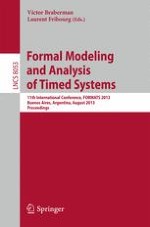This book constitutes the refereed proceedings of the 11th International Conference on Formal Modeling and Analysis of Timed Systems, FORMATS 2013, held in Buenos Aires, Argentina, in August 2013.
The 18 revised full papers presented were carefully reviewed and selected from 41 submissions. The book covers topics of foundations and semantics (theoretical foundations of timed systems and languages; comparison between different models, such as timed automata, timed Petri nets, hybrid automata, timed process algebra, max-plus algebra, probabilistic models); methods and Tools (techniques, algorithms, data structures, and software tools for analyzing timed systems and resolving temporal constraints, e.g., scheduling, worst-case execution time analysis, optimization, model checking, testing, constraint solving, etc.); applications (adaptation and specialization of timing technology in application domains in which timing plays an important role, e.g., real-time software, hardware circuits, and problems of scheduling in manufacturing and telecommunications).
